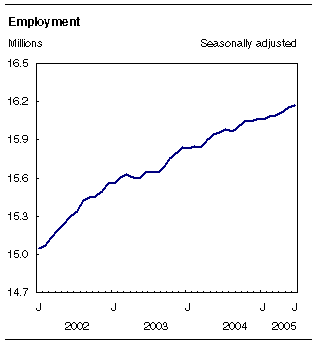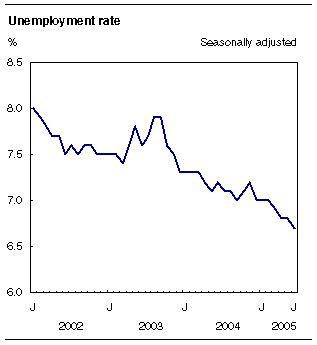
















 |
|
 |                |
Information identified as archived is provided for reference, research or recordkeeping purposes. It is not subject to the Government of Canada Web Standards and has not been altered or updated since it was archived. Please "contact us" to request a format other than those available.

|

Friday, July 8, 2005 Labour Force SurveyJune 2005Employment edged up 14,000 in June, bringing total gains during the second quarter to 79,000 (+0.5%), three times the growth rate observed in the first quarter of 2005. The unemployment rate edged down to 6.7% in June, equalling the lowest rate in almost three decades last set in June 2000. 
Gains in full-time jobs among adult womenFull-time employment rose by 52,000 in June but this was partly offset by 38,000 fewer part-time jobs. Most of the full-time gain in June was among women aged 25 and over. Employment among adult women was up 18,000 in June, driven by a large gain in full-time jobs (+39,000). There was little overall employment change in June among youths and adult men.
So far this year, overall employment has increased by 0.6%. Adult men led the increase (+1.1%) with gains in full- and part-time jobs. Over the same period, employment among adult women was up 0.8% with all of the gain in full time. Youths have not fared well so far this year with employment for this group falling by 1.1%, with almost all of the weakness in part-time jobs. Summer job market for studentsDespite encouraging signs in May, the summer job market for students aged 20 to 24 slowed in June (See Note to readers). The employment rate for this group of students was 69.6%, down a full 3 percentage points from a year earlier. The proportion of students employed in June 2005, although lower than the same time last year, remains higher than in any other June since 1995. 
Strength in constructionEmployment in construction increased by 21,000 in June and was spread across a number of provinces. This increase offset the decline in May and leaves employment in the sector up 7.6% (+72,000) since June 2004. Employment in education was up 11,000 in June, part of a longer term trend towards more jobs in that industry. Although employment in manufacturing was little changed in June, there were 78,000 (-3.4%) fewer people working in the industry than a year earlier. The largest declines over the last 12 months have been in wood, clothing, as well as in motor vehicle and parts manufacturing. Employment in natural resources was also little changed in June. However, there has been solid job growth of 31,000 (+10.9%) since April 2004. The majority of the gains over this period were driven by continuing strength in the Alberta oil patch. Employment in transportation and warehousing fell by 19,000 in June, offsetting most of the jobs added in May. This leaves the number of workers in this sector at about the same level as at the end of 2004. Declines in June were mainly in scenic and sightseeing transportation as well as in warehousing and storage. Employment also declined in information, culture and recreation (-15,000) in June, with losses mainly in amusement, gambling and recreation as well as in broadcasting and telecommunications. Over the first half of 2005, employment has increased in agriculture (+8.1%), educational services (+3.8%), business, building and other supports services (+3.4%), construction (+3.0%), as well as in natural resources (+3.0%). There have been declines over the same period in information, culture and recreation (-2.6%), manufacturing (-2.5%), and accommodation and food services (-2.0%). More jobs in Quebec and Newfoundland and LabradorEmployment in Quebec bounced back by 26,000 in June. The gains were in full-time jobs and were led by increases in health care and social assistance as well as in construction. Employment in the province remains at about the same level as at the start of the year. The unemployment rate in June fell 0.5 percentage points to 8.0%. Employment also increased in Newfoundland and Labrador with 4,000 added workers in June. The increase was mostly in food processing manufacturing with smaller gains in construction. With this increase, employment in the province is at about the same level as at the end of 2004. In June, the unemployment rate declined 1.3 percentage points to 13.9%, the lowest level since December 1999. There were fewer people working in New Brunswick as employment decreased by 6,000 in June, with just over half of the decline occurring among youths. The job loss in June offset a similar increase in May. The declines in June were spread in health care and social assistance and in accommodation and food services. The unemployment rate rose 0.9 percentage points in June to 9.7%. Employment also declined in Nova Scotia, down 5,000 in June and was spread across a number of sectors. This decrease brings employment in the province to approximately the same level as at the end of 2004. The unemployment rate increased 0.9 percentage points in June to 8.6%. Although employment was little changed in Ontario in June, there were 63,000 (+1.0%) more people working in the province compared to the start of the year. Ontario continues to show weakness in manufacturing. However, job losses in this sector have been offset by gains in trade, construction and educational services. Employment was also little changed in Alberta and British Columbia in June. However, both provinces have shown job gains over the past 12 months. Employment in British Columbia is up 2.7% since June 2004. There has been job strength for the province in business, building and other support services as well as in construction. Alberta posted a more moderate increase of 1.4% over the same period, led by gains in natural resources. There was little change in the other provinces in June. Available on CANSIM: tables 282-0001 to 282-0042, 282-0047 to 282-0064, 282-0069 to 282-0096 and 282-0098. Definitions, data sources and methods: survey number 3701. Available at 7:00 a.m. on our Web site. From the home page, choose Today's news releases from The Daily, then Latest Labour Force Survey. A more detailed summary, Labour Force Information, is available today for the week ending June 18 (71-001-XIE, $9/$84). Data tables are also available in the Canadian Statistics module of our Web site. The next release of the Labour Force Survey will be on Friday, August 5. For general information or to order data, contact Client Services (1-866-873-8788; 613-951-4090; labour@statcan.gc.ca). To enquire about the concepts, methods or data quality of this release, contact Vincent Ferrao (613-951-4750) or Jeannine Usalcas (613-951-4720), Labour Statistics Division.
| ||||||||||||||||||||||||||||||||||||||||||||||||||||||||||||||||||||||||||||||||||||||||||||||||||||||||||||||||||||||||||||||||||||||||||||||||||||||||||||||||||||||||||||||||||||||||||||||||||||||||||||||||||||||||||||||||||||||||||||||||||||||||||||||||||||||||||||||||||||||||||||||||||||||||||||||||||||||||||||||||||||||||||||||||||||||||||||||||||||||||||||||||||||||||||||||||||||||||||||||||||||||||||||||||||||||||||||||||||||||||||||||||||||||||||||||||||||||||||||||||||||||||||||||||||||||||||||||||||||||||||||||||||||||||||||||||||||||||||||||||||||||||||||||||||||||||||||||||||||||||||||||||||||||||||||||||||||||||||||||||||||||||||||||||||||||||||||||||||||||||||||||||||||||||||||||||||||||||||||||||||||||||||||||||||||||||||||||||||||||||||||||||||||||||||||||||||||||||||||||||||||||||||||||||||||||||||||||||||||||||||||||||||||||||||||||||||||||||||||||||||||||||||||||||||||||||||||||||||||||||||||||||||||||||||||||||
|
|
|